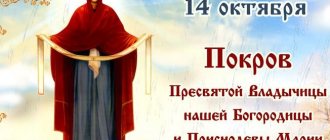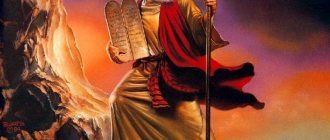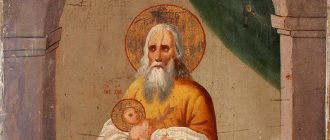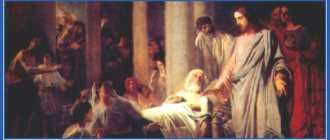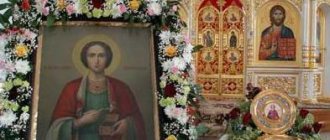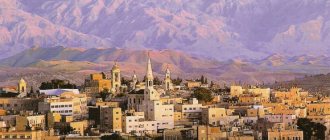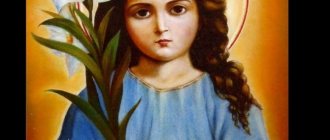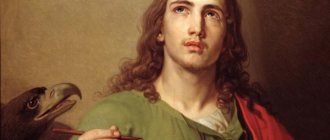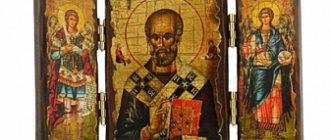Among the preserved national and cultural treasures, there is a huge number of the greatest works of art, the main characters of which are ancient religious characters. Their illustrations, presented on wooden canvases, clearly reflect sacred images that were taken from the Bible. Among the most revered compositions, which from ancient times continue to be significant for society, one should be highlighted whose miraculous properties are especially important even for airborne troops.
We are talking about the great icon of Elijah the Prophet. Its first image appeared during the existence of the Byzantine state. In it, the prophet Elijah appears as an overweight man with a stern frown. On his body you can see a red woolen cloak that covers the back of his back. And on the lower part of the face a thick and long beard grows. In other later works, Ilya can be seen holding a dagger in his hand. According to some definitions, this item allows you to convey the special rage that the main character experiences towards non-believers.
Icon of Elijah the prophet
Elijah the prophet. Icon, XV century. From the Intercession Church in the village. Rakuly (Arkhangelsk region).
According to sources, the first known Christian church in Rus' was dedicated to this Old Testament prophet. And with the acceptance of baptism by Prince Vladimir, the veneration of the saint increased more and more, hundreds of churches were built in his honor. And now the icon of Elijah the prophet is found in almost every church.
Day of Honor
The veneration of St. Elijah is held on August 2 (July 20 according to the Old Slavonic calendar). This day is also a holiday of the airborne forces. Since August 2, Orthodox people were prohibited from swimming in rivers and reservoirs. Believers believe that on this day the saint strikes demons and sinners with lightning. Also on the day of his veneration, frequent thunderstorms are observed, which leads to the death of swimmers.
Before the popularization of Christianity, paganism was widespread. People celebrated the day of Perun as an analogue of the modern day of Ilya. Fires on this day were considered as punishment for sins. They extinguished the house not with water, as usual, but with milk or specially infused whey. This is no longer observed in Christianity.
As an offering to the prophet, on August 2, during a thunderstorm or rain, people put bread and salt outside the window, and when the bad weather ended, they took them to the river.
During the Feast of Elijah, believers brought donations to the church. It was a leg of lamb, honey, green peas, and fresh rye. They left one part of the offerings they brought in the temple, and took the second with them. It was also believed that after the holiday, wolf holes opened. Therefore, they began their first hunt for these animals at the end of the holiday or during it. Hunters believed that if they hunt down a wolf on Elijah's day, it will bring good luck for the whole year. The week after the start of the holiday was called the beast week, since at this time cases of bear attacks became more frequent.
The name of the saint was used for spells and healing beliefs. Believers believed that the candles that were melted from the snake killed that day had miraculous powers in the treatment of diseases.
Proclaimer of God's will
Unlike many biblical prophets, whose books are part of the Old Testament, the saint did not leave written works. The biblical text only talks about the deeds of the ascetic himself in the 3rd and 4th Books of Kings.
At the same time, except for the place of birth of the saint of God, the Gilead city of Thesvah, there is no information about his origin, family, or ascetic path. Chapter 17 of 3 of the Book of Kings presents Elijah immediately as a prophet - a proclaimer of the will of God. This, according to the Bible, is the essence of his life, completely given to the Creator:
- the first appearance of the saint on the pages of the Bible is his denunciation of the wicked apostate King Ahab with the announcement of God's punishment: a terrible drought throughout Palestine;
- then we see the prophet working alone in a cave, where, at the command of the Lord, a raven brings him bread; he works miracles in pagan Sarepta, where he saves a widow and her son from an outbreak of famine, and subsequently resurrects a youth who died of illness.
The “spirit and power” of Elijah are especially clearly manifested during his competition with the priests of Baal, whose cult spread among the chosen people during the reign of Ahab. Through the prayer of the saint, the heavenly fire burned not only the burnt offering he had prepared, but even the altar itself, while the “prophets of Baal,” begging their “god” for many hours, achieved nothing. Thus, the faith of the prophet turned the people of Israel, who had retreated from Him, to God.
This is the whole life of the prophet, given to the service of the Lord. Only sometimes does the Bible seem to lift the veil over his completely human infirmities. For example, after performing a miraculous sacrifice, Elijah almost falls into despair: the people he converted have again cooled to the faith, and murderers are looking for the prophet himself. But with God’s help, the prophet overcomes everything, a sign of which is the miraculous completion of his earthly life, when a chariot of fire appears and takes him and his body to Heaven, to the Lord. So the saint became the second of the people (after the righteous Enoch) who did not know death.
Since ancient times, Christians have firmly believed: before the Second Coming of the Lord, Elijah, His faithful servant, will appear to the world once again to expose its iniquities and prepare the faithful for the final Judgment.
This is interesting: Saint Elijah - the Prophet who did not die
Ikos 4
The wicked king Ahab heard your command to gather the entire tribe of Israel to Mount Carmel, and to bring the cold prophets of Baal to that place, sending Abiy, gathering them all, and he himself came there. But you, a zealot for the glory of God, although of course you should disgrace vile idols and glorify the True God, you commanded to prepare two sacrifices, but not to bring fire upon you, saying: “And the God who listens with fire will be God.” Then all the people heard it and decided: “The good word of Eliin, let it be so.” We, magnifying you, call:
Rejoice, great messenger of the Heavenly King and herald of His holy commandments; Rejoice, adamante, invincible in jealousy and unshakable pillar of piety.
Rejoice, strong defender of the truth and firm opponent of the enemies of God; Rejoice, destroyer of wickedness and planter of piety.
Rejoice, fiery zealot of Divine glory; Rejoice, for in the last days of the world you preached the True God and exposed the accursed Antichrist.
Rejoice, Elijah, great prophet, glorious forerunner of the Second Coming of Christ.
Iconographic appearance
The Rise of Elijah the Prophet on a Chariot of Fire
Elijah is the seer of God, with whom the Creator spoke on Mount Horeb in the “breath of the quiet wind” (1 Kings 19:12). He is also a denouncer of wicked idolaters, a zealous preacher of the faith. The coming of the Messiah and the expectation of the end of the world are associated with the prophet. Finally, since ancient times the ascension of the saint of God into heaven has amazed the imagination of believers. All these, as well as many other, events in the prophet’s life are reflected in his iconography, which concerns both the events of his earthly life and those that occurred after his ascension - for example, the appearance of the prophet on the Mount of Transfiguration, where he and the prophet. Moses talked with Christ Himself.
However, what is common to all icons is the image of the ascetic, whose image has been preserved by church tradition since ancient times. St. Elijah is most often written as a tall, gray-haired old man with long hair. But the saint’s robes are written differently:
- most often he wears the famous mantle (even in the 9th century, a piece of it could be venerated in the Church of St. Sophia in Constantinople), or a woolen cloak, the clothing of a hermit;
- sometimes, especially on the icons of the Transfiguration, the saint is depicted dressed in clothes similar to the apostles - in a tunic, himation; this emphasizes the connection of the prophet with the coming of the Messiah, Christ.
Transfiguration. Feofan the Greek
If the saint is depicted alone, in his hand there is most often a scroll with the text of the prophecy. The other hand is raised in an oratorical gesture that was understandable to the people of that time, because the ascetic’s life’s work was preaching the faith.
However, such, as theologians say, “sole” images of St. Elijah, not very much. More often than not, icons are a reflection of particularly significant events in his life.
Temple of Elijah the Prophet on Mount Carmel in Israel
For several centuries in a row, pilgrims from all over the world have been coming to Mount Carmel to touch the shrines associated with the prophet. The place for the temple was not chosen by chance, because it was in the cave of this mountain that Ilya hid from his pursuers for a long time, and here he defeated the pagan priest. The temple was built directly above the cave in the shape of a cross.
In the courtyard there is a small altar, similar to the one that Ilya created in his time. Nearby stands a neat statue of the prophet, who raised his hand with a blade over the pagan priest. When the Arab Muslim army waged war on the Jews, they cut off the hand of the statue, believing that it was helping all the people in the war. The temple was built relatively recently - in the first quarter of the 20th century, on the day of memory of St. Elijah. Every year believers flock here to pray or baptize their children.
Scenes from the life of the saint and their meaning
Christian theologians have long noticed how deeply symbolic the events of the saint’s life, reflected in the biblical text, have. Many of them can be called prototypes of the New Testament. That is why, for example, an icon depicting St. Elijah by the brook Cherith, and the raven who brought him a round loaf of bread.
Interesting fact
This image was often painted in the altar part of the temple, because the plot of the life is a kind of prototype of the Eucharist.
Iconography: Elijah the Prophet in the desert Dates: XVI century. Around 1552. Material: Wood, tempera. Dimensions of the icon: height 75.5 cm, width 56 cm. In the center is the figure of a seated Elijah the Prophet. In the upper left corner there is a dark bird with an egg in its beak. A rare feature of iconography: Elijah the Prophet looks ahead and does not look back. Among the well-known monuments, a similar scheme is present in the 15th century icons from the Ilyinsky chapel of the village of Pyalma in Obonezhye (Museum of Fine Arts of the Republic of Karelia. Inv. No. I-363) and from the Bryagin collection by a Central Russian master (RM). Elijah the Prophet is depicted sitting on a large round stone between the gorges of yellow ocher hills, behind him is a dark crevice of a cave. At his feet is a blue stream of water. Inv. No. KMZ KP 02139. © Kostroma State Historical, Architectural and Art Museum-Reserve
Among other subjects with symbolic meaning, common in icon painting:
- the resurrection of a widow's son, comparable to the resurrection of St. Lazarus by Christ, which also symbolizes the coming general resurrection;
- the sacrifice of Elijah at Carmel, foreshadowing the future Descent of the Holy Spirit on the Apostles - also heavenly fire, but not burning, but changing the souls of people;
- the ascension of the saint to heaven on a fiery chariot, also like a prophecy about the Ascension of the Risen Christ Himself.
The oldest images that have come down to us
It is believed that of the currently preserved icons of the saint, the oldest is located in the Basilica of San Lorenzo Maggiore (Milan, Italy). It dates back to approximately 370. Historians find it difficult to accurately date this fresco, since it is poorly preserved. However, from the existing fragments it is clear that this is an image of the “fiery ascension” of St. Elijah.
Another icon, dating back to 549, is also known in the Basilica of Saint Appolinare in the Italian city of Ravenna. He is on the icon of the Transfiguration of the Lord: here Elijah is depicted on a cloud.
Symbolic image of the Transfiguration of the Lord in the Basilica of Sant'Apollinare in Classe in Ravenna (c. 549). The Prophet Elijah is depicted as an old man on the right, and the Prophet Moses on the left.
Also by the 6th century. The mosaic of the monastery of St. Catherine (Mount Sinai). This is also the Transfiguration, where St. Elijah is shown giving a blessing. He is dressed in a chiton with a black belt decorated with crosses and a mantle.
Features of Russian icon painting
Christian Rus' inherited both the tradition of venerating the prophet and the iconographic canons according to which he was depicted.
The oldest fresco depicting the prophet is located in the St. Sophia Cathedral in Kyiv; it dates back to the beginning of the 11th century. This is a full-length image of the prophet holding a scroll, which is quite consistent with the Byzantine tradition.
But already by the 13th century. Russian icon painters have their own peculiarities in depicting the prophet:
- the image of the saint of God already by the 14th century. often found next to the dome icon of the Savior, on one of the pillars, usually together with St. John the Baptist; it is assumed that this is connected with the tradition of hesychasm that has spread throughout the Russian lands, dating back to St. Gregory Palamas, who gave the prophet special significance as the predecessor of the silent hermits;
In “Triads for the Protection of the Sacredly Silent” St. Gregory writes about the appearance of the Lord to Elijah in the cave of Mount Horeb, which is described by the Bible as a “breathing of a quiet wind”:
“Testimony and truthful news are his generally accepted nickname: everyone calls him a God-seer and even a supreme God-seer.”
- it is often written on the margins of the “Sign” icon of the Mother of God, since this image of the Most Pure One with raised hands is sometimes also called the “Incarnation”; the image of the prophet emphasizes his role as the herald of the coming of the Messiah;
- in general the face of St. Elijah can often be seen on the margins of icons of holidays, images of the Mother of God, Christ, along with other selected saints;
- already the patristic tradition often compared two righteous people who lived in different centuries - prophet. Elijah and St. Nicholas of Myra; the inhabitants of Rus' also often resorted to these saints of God, and therefore the icon-painting tradition soon began to unite the saints: their joint icons appeared;
- venerating the saint as the patron saint of peasants who takes care of the harvest, they began to write him along with other saints of God, especially beloved by rural residents: for example, the Great Martyr. St. George the Victorious, martyr. Blasius.
Saint Elijah the Prophet with his life in 26 hallmarks
Finally, very popular from the 15th-16th centuries. become “hagiographical” icons of the prophet, where the marks surrounding his image represent the events of his life.
Interesting fact
There is also a unique “hagiographical” cycle of frescoes of the saint - in the Yaroslavl temple dedicated to him. The Elias Church itself was built from 1647 to 1650, and was consecrated on June 16, 1650.
The frescoes of the life of the saint date back to 1680. The narrative in colors begins on the southern wall of the church with the birth of the prophet (the basis of the plot was apocryphal legends), and ends on the northern wall, with the image of the “fiery ascent” of the saint.
What do believers pray for?
The saint is most often addressed:
- during natural disasters, be it drought, or, on the contrary, prolonged bad weather, storm, hail, or other disasters;
- asking for help during persecution for faith, when attacked by enemies;
- in case of sinful temptations, with a request to strengthen faith and prayer.
Thus, popular love for the prophet gave rise to a large and varied tradition of his images. By resorting to this image with the faith that the saint will definitely help, many receive what they ask for.
Natalia Sazonova
Lyrics
The prayer asks Elias to pray to God that he:
- gave those praying a spirit of repentance and contrition for sins;
- helped them leave the wicked path and succeed in their endeavors;
- strengthened their faith in the fight against passion and lust;
- instilled in their hearts humility, love of neighbor, meekness, patience and chastity;
- saved their souls and turned away his wrath from them.
Prayer also offers worship to God and Jesus Christ.
The troparion to the prophet Elijah says that:
- he is an angel in the flesh and the foundation of the prophets;
- Elias is the harbinger of the second coming;
- he sent grace to Elisha.
In the kontakion, the prophet is asked to send rain and pray for people before God. This is due to the fact that Christians believe in his ability to control the weather. The legends also say that he spoke with God face to face. For this reason, Elijah the Prophet can stop the disasters and misfortunes that come along the path of believers.
Troparion
In the flesh, the Angel,/ the foundation of the prophets,/ the second Forerunner of the coming of Christ, the glorious Elijah,/ sending grace to Elisha from above,/ to drive away illnesses/ and cleanse lepers,// also to those who worship him Reads healing.
